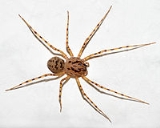
Scytodes thoracica
Encyclopedia
Scytodes thoracica is a spitting spider
because it spits a poisonous sticky silken substance over its prey. Its size ranges between 3 –. The carapace is unusual in sloping upwards towards its rear end, whereas the abdomen slopes downwards.
It has six eyes instead of the eight spiders usually have. It is found in the Holarctic
, Australia
, and on some ocean
ic islands in the Pacific
.
This particular spitting spider features the presence of silk glands in its head-breast part. Besides the silk glands in its abdomen, the spider also has silk glands connected with its poison glands. In this way the spiders has the ability to make poisonous silk. Other Arachnidae (spider-like creatures) may also have silk glands in their head-breast part like the pseudo-scorpions.
In contrast to the Pseudoscorpion
s that use the silk from the head-breast glands to make nests, the 'spitting spider' uses it to catch prey in a very particular way. It is a very slow hunter as its long and tender legs may suggest. During night, when all insects are at rest, Scytodes starts its hunt. The spider sneaks very carefully towards its prey and, from about 10 mm (0.393700787401575 in), stops and carefully measures the distance to its prey with one front leg without disturbing it. Then it squeezes the back of its body together and spits two poisonous silk threads, in 1/600 sec, in a zigzag manner over the victim. The prey is immediately immobilized. When the prey is larger the spider spits several times. It is assumed the spider uses special long hearing hairs located at its legs to locate its prey.
The mother does not make a nest, but carries her eggs under her belly in a net of silk.
Scytodes thoracica is nocturnal. It prefers warm temperatures and is not rare inside houses.
In Southern Europe, it can be found under stones outside houses. In Northern Europe it can only be found in houses.
Spitting spider
Spitting spiders are members of the family Scytodidae. There are several genera, of which Scytodes is the best-known. Over 150 species of scytodids have been described worldwide....
because it spits a poisonous sticky silken substance over its prey. Its size ranges between 3 –. The carapace is unusual in sloping upwards towards its rear end, whereas the abdomen slopes downwards.
It has six eyes instead of the eight spiders usually have. It is found in the Holarctic
Holarctic
The Holarctic ecozone refers to the habitats found throughout the northern continents of the world as a whole. This region is divided into the Palearctic, consisting of Northern Africa and all of Eurasia, with the exception of Southeast Asia and the Indian subcontinent, and the Nearctic,...
, Australia
Australia
Australia , officially the Commonwealth of Australia, is a country in the Southern Hemisphere comprising the mainland of the Australian continent, the island of Tasmania, and numerous smaller islands in the Indian and Pacific Oceans. It is the world's sixth-largest country by total area...
, and on some ocean
Ocean
An ocean is a major body of saline water, and a principal component of the hydrosphere. Approximately 71% of the Earth's surface is covered by ocean, a continuous body of water that is customarily divided into several principal oceans and smaller seas.More than half of this area is over 3,000...
ic islands in the Pacific
Pacific Islands
The Pacific Islands comprise 20,000 to 30,000 islands in the Pacific Ocean. The islands are also sometimes collectively called Oceania, although Oceania is sometimes defined as also including Australasia and the Malay Archipelago....
.
This particular spitting spider features the presence of silk glands in its head-breast part. Besides the silk glands in its abdomen, the spider also has silk glands connected with its poison glands. In this way the spiders has the ability to make poisonous silk. Other Arachnidae (spider-like creatures) may also have silk glands in their head-breast part like the pseudo-scorpions.
In contrast to the Pseudoscorpion
Pseudoscorpion
A pseudoscorpion, , is an arachnid belonging to the order Pseudoscorpionida, also known as Pseudoscorpiones or Chelonethida....
s that use the silk from the head-breast glands to make nests, the 'spitting spider' uses it to catch prey in a very particular way. It is a very slow hunter as its long and tender legs may suggest. During night, when all insects are at rest, Scytodes starts its hunt. The spider sneaks very carefully towards its prey and, from about 10 mm (0.393700787401575 in), stops and carefully measures the distance to its prey with one front leg without disturbing it. Then it squeezes the back of its body together and spits two poisonous silk threads, in 1/600 sec, in a zigzag manner over the victim. The prey is immediately immobilized. When the prey is larger the spider spits several times. It is assumed the spider uses special long hearing hairs located at its legs to locate its prey.
The mother does not make a nest, but carries her eggs under her belly in a net of silk.
Scytodes thoracica is nocturnal. It prefers warm temperatures and is not rare inside houses.
In Southern Europe, it can be found under stones outside houses. In Northern Europe it can only be found in houses.

